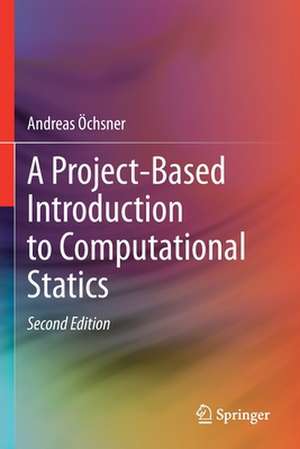A Project-Based Introduction to Computational Statics
Autor Andreas Öchsneren Limba Engleză Paperback – 14 noi 2021
For this new, 2nd edition, many examples and design modifications have been added, so that the learning-by-doing features of this book make it easier to understand the concepts and put them into practice.
The theoretical derivations are provided as additional reading and students must study and review the derivations in a self-study approach. The book provides the theoretical foundations to solve a comprehensive design project in tensile testing. A classical clip-on extensometer serves as the demonstrator on which to apply the provided concepts. The major goal is to derive the calibration curve based on different approaches, i.e., analytical mechanics and based on the finite element method, and to consider further design questions such as technical drawings, manufacturing, and cost assessment. Working with two concepts, i.e., analytical and computational mechanics strengthens the vertical integration of knowledge and allows the student to compare and understand the different concepts, as well as highlighting the essential need for benchmarking any numerical result.
| Toate formatele și edițiile | Preț | Express |
|---|---|---|
| Paperback (2) | 583.28 lei 6-8 săpt. | |
| Springer International Publishing – 14 noi 2021 | 583.28 lei 6-8 săpt. | |
| Springer International Publishing – 4 sep 2018 | 719.49 lei 39-44 zile | |
| Hardback (1) | 645.96 lei 6-8 săpt. | |
| Springer International Publishing – 14 noi 2020 | 645.96 lei 6-8 săpt. |
Preț: 583.28 lei
Preț vechi: 686.21 lei
-15% Nou
Puncte Express: 875
Preț estimativ în valută:
111.61€ • 116.77$ • 92.72£
111.61€ • 116.77$ • 92.72£
Carte tipărită la comandă
Livrare economică 03-17 aprilie
Preluare comenzi: 021 569.72.76
Specificații
ISBN-13: 9783030587734
ISBN-10: 3030587738
Pagini: 262
Ilustrații: XVIII, 262 p. 193 illus., 140 illus. in color.
Dimensiuni: 155 x 235 mm
Greutate: 0.4 kg
Ediția:2nd ed. 2021
Editura: Springer International Publishing
Colecția Springer
Locul publicării:Cham, Switzerland
ISBN-10: 3030587738
Pagini: 262
Ilustrații: XVIII, 262 p. 193 illus., 140 illus. in color.
Dimensiuni: 155 x 235 mm
Greutate: 0.4 kg
Ediția:2nd ed. 2021
Editura: Springer International Publishing
Colecția Springer
Locul publicării:Cham, Switzerland
Cuprins
Introduction and Problem Formulation.- Review of Analytical Mechanics.- Finite Element Method.- Outlook: Two- and Three-Dimensional Elements.- Answers to Supplementary Problems.
Notă biografică
Andreas Öchsner is a Full Professor at the School of Engineering, Griffith University, Australia and Leader of the Mechanical Engineering Program (Head of Discipline and Program Director). Having obtained a Dipl.-Ing. degree in Aeronautical Engineering at the University of Stuttgart (1997), Germany, he served as a research and teaching assistant at the University of Erlangen-Nuremberg from 1997 to 2003 while working to complete his Doctor of Engineering Sciences (Dr.-Ing.) degree. From 2003 to 2006, he was an Assistant Professor at the Department of Mechanical Engineering and Head of the Cellular Metals Group affiliated with the University of Aveiro, Portugal. He spent seven years (2007–2013) as a Full Professor at the Department of Applied Mechanics, Tndreas Öcechnical University of Malaysia, where he was also Head of the Advanced Materials and Structure Lab.
Textul de pe ultima copertă
This book uses a novel concept to teach the finite element method, applying it to solid mechanics. This major conceptual shift takes away lengthy theoretical derivations in the face-to-face interactions with students and focuses on the summary of key equations and concepts; and to practice these on well-chosen example problems.
For this new, 2nd edition, many examples and design modifications have been added, so that the learning-by-doing features of this book make it easier to understand the concepts and put them into practice.
The theoretical derivations are provided as additional reading and students must study and review the derivations in a self-study approach. The book provides the theoretical foundations to solve a comprehensive design project in tensile testing. A classical clip-on extensometer serves as the demonstrator on which to apply the provided concepts. The major goal is to derive the calibration curve based on different approaches, i.e.,analytical mechanics and based on the finite element method, and to consider further design questions such as technical drawings, manufacturing, and cost assessment. Working with two concepts, i.e., analytical and computational mechanics strengthens the vertical integration of knowledge and allows the student to compare and understand the different concepts, as well as highlighting the essential need for benchmarking any numerical result.
For this new, 2nd edition, many examples and design modifications have been added, so that the learning-by-doing features of this book make it easier to understand the concepts and put them into practice.
The theoretical derivations are provided as additional reading and students must study and review the derivations in a self-study approach. The book provides the theoretical foundations to solve a comprehensive design project in tensile testing. A classical clip-on extensometer serves as the demonstrator on which to apply the provided concepts. The major goal is to derive the calibration curve based on different approaches, i.e.,analytical mechanics and based on the finite element method, and to consider further design questions such as technical drawings, manufacturing, and cost assessment. Working with two concepts, i.e., analytical and computational mechanics strengthens the vertical integration of knowledge and allows the student to compare and understand the different concepts, as well as highlighting the essential need for benchmarking any numerical result.
Caracteristici
Uses a novel concept to teach the finite element method, applying it to solid mechanics New edition offers many additional examples and design modifications Focuses on the summary of key equations and concepts taking away lengthy theoretical derivations Provides the theoretical foundations to solve a comprehensive design project in tensile testing
